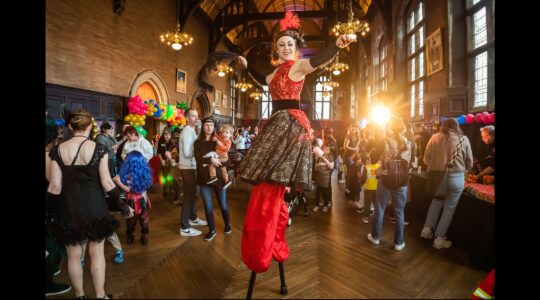The superhero Spiderman has made the leap from printed page to movie screens across the country, but one giant of the comic-book industry says he is still battling for mainstream legitimacy.
Will Eisner, the creator of the 1940s comic book hero “The Spirit,” is not after box-office proceeds or merchandising spin-offs. Instead he wants recognition for comic books as a literary art form.
“This medium is capable of storytelling well beyond the business of two mutants trashing each other,” Eisner, 85, told The Jewish Week in a recent telephone interview from his home in Florida.
His 70 years of brushwork stand as proof of this contention: From his early days as a pioneer of expressionistic comic books to his recent decades of devotion to the “graphic novel,” Eisner has been telling stories that move beyond the themes of what he calls “vengeance and pursuit” to delve into the more subtle shades of human survival.
His influence in changing the visual vocabulary of comic books is inescapable; in fact, the “Eisners” are the comic-book industry’s equivalent of the “Oscar” awards. His unshakable faith in the value of comic books provided the inspiration for Josef Kavalier in Michael Chabon’s Pulitzer Prize-winning novel, “The Amazing Adventures of Kavalier and Klay.” Now signs of broader approbation, however slow in coming, are on the horizon.
“I once told a [comic book] distributor at a convention that I built a toll road on an empty field,” Eisner says. “Now I hear the trucks.”
One such vehicle is heading Eisner’s way next week, when he will receive a Lifetime Achievement Award from the National Foundation for Jewish Culture. The 22-year-old foundation promotes Jewish arts and letters.
For the last 13 years, the foundation has awarded Jewish greats in the fields of visual, literary, performing and media arts, as well as arts patronage. Eisner’s award is a departure from the foundation’s usual program and puts him in the company of the actor and singer Theodore Bikel, who took home the foundation’s first such award in 1997.
In the past, the foundation has honored such Jewish luminaries as Elie Wiesel, Cynthia Ozick, Philip Roth, Maurice Sendak and Arthur Miller. And while Eisner’s name may not carry the same publicity punch as those — or the Pulitzer Prize-winning cartoonist Art Spiegelman, who won the visual arts prize in 1996 — he was “a natural” choice, according to Richard Siegel, the foundation’s executive director.
“Part of the function of the awards is that they help to define the broad parameters of what we understand to be the Jewish cultural experience in America,” says Siegel. Honoring Eisner is “recognition that in many ways the [comic book] genre is a Jewish-created genre.”
Indeed, Jewish names abound in the pantheon of comic book creators of the 1930s and 1940s: Jerome Siegel and Joe Shuster (“Superman”), Martin Nodell (“Green Lantern”), Bob Kane and Bill Finger (“Batman”), and Stan Lee (“Spider-Man”). In the early days, Eisner says, comic books were regarded as “trash and junk” and, like the rag and junk trades, “the only people who would go into [them] were people who had very little opportunity anywhere else.” Young Jewish artists, many of whom, like Eisner, were the sons of immigrants, quickly gravitated to comic books.
But while many of his Jewish peers fashioned cultural icons, Eisner started an artistic revolution. He added rhythm and velocity to the comics, which had previously been series of nine or 12 square panels. He manipulated the panels’ number, order and shape, used the lettering to illustrate his stories, and experimented with different perspectives, among other innovations.
Born in New York City, Eisner had studied art at the New York Art Student’s League. He illustrated pages for a comic book called “WOW What A Magazine!” and in the late 1930s joined up with partner Jerry Iger to start the Iger-Eisner studio. The first “comic art shop,” the studio churned out comics to publishers’ orders and employed such industry heavyweights as Kane, Lou Fine and Jack Kirby.
In 1939, Eisner got an offer to start a comic book as an insert to Sunday newspapers. Tired of creating strips for what he once called “15-year-old cretins in Kansas,” he jumped at the chance to address an adult audience. “You can’t talk about heartbreak to a kid,” he says.
The result was “The Spirit,” a masked crime-fighter named Det. Denny Colt who fought injustice wearing a business suit and without the use of superpowers or special gadgets. In his weekly tales of the city, Eisner took on troubling social issues, such as spousal abuse, urban blight, and graft. “The Spirit” ran until 1952, and reached its height with 5 million readers in 20 newspapers.
“Unlike any other comic book artist of his time, he created mood, atmosphere and a sense of reality — albeit a cartoon reality,” says cartoonist Jules Feiffer, who got his start in 1946 as a 16-year-old “office groupie” in Eisner’s studio and eventually wrote the “Spirit” stories.
Like Feiffer, Eisner grew up in the slums of the Bronx, one of two sons born to a painter who often had trouble making ends meet. Many people recognize in Eisner’s work the language and drama that pervaded New York’s ethnic neighborhoods in the 1930s.
“Comics are to art what Yiddish is to language,” Spiegelman said in an interview. “It is the vernacular language of a certain kind, they embrace and subsume a lot of other things into its chulent and makes this kind of weird stew.”
“There are some artists who happen to be Jewish and eventually can somehow make a case that they’ve made a Jewish contribution to the arts by being born in the right tribe,” Spiegelman says, adding that that’s not the case with Eisner. “His name might have been Denny Colt. But he was clearly circumcised.”
Eisner says he never intended for “The Spirit” to be an overtly Jewish character. But he acknowledges that his work was strongly influenced by his roots, as much as by Milton Caniff’s “Terry and the Pirates” comics, pulp fiction magazines and the short stories of O. Henry and Saki, which he bought in secondhand bookstores along lower Fourth Avenue in Manhattan.
He took up Jewish themes beginning in the 1970s, when he was roused by the underground comics movement to look at comic books as a form of social commentary. At the time, Eisner ran a publishing company that produced educational materials in comics form. Suddenly, he saw the beginning realization of his life’s ambition: comics as “pure literature.”
In 1978, he published “A Contract With God,” the first of a genre he would call the “graphic novel.” Eisner says he coined the term as an “act of desperation” in an attempt to interest a major publisher in his new medium. The book is really a collection of riveting yet unsparingly bleak short stories about life in a Jewish tenement in the Bronx.
He followed that volume with a stream of publications infused with a sense of Yiddishkeit: “The Dreamer” (1986); the autobiographical work, “To the Heart of the Storm” (1991), “Dropsie Avenue, the Neighborhood” (in 1995), and “Minor Miracles” (2000), among 15 others, including works for children and two instructional manuals for comic book artists. He has just completed a new illustrated novel, titled “The Name of the Game,” about the institution of marriage, and is at work on a new book.
“The Spirit” has been reprinted and revived several times over the past half century. Some of those reprints found their way to a teen-age Spiegelman in the early 1960s. “I was 14 or 15 years old,” says the author of the prize-winning “Maus.” “The perfect moment to be imprinted.”
Spiegelman first championed Eisner’s name for consideration at the foundation and will introduce his mentor at the awards ceremony on June 3. Eisner will be honored along with the artist Helene Ayalon, filmmaker Alan Berliner, singer-composer Debbie Friedman, literary critic Theodore Solotaroff and philanthropist Carol Spinner.
A 10-person panel selected the award winners. The panel includes Bikel; Archie Rand, a painter and professor at Columbia University; Norman Kleeblatt, head curator at The Jewish Museum; Robin Cembalest, executive editor of Art News magazine; author and essayist Nessa Rapoport; novelist and critic Jonathan Rosen; literary critic Morris Dickstein; the director of Symphony Space, Isaiah Sheffer; Annette Insdorf, head of the Columbia University Film Department; film critic David Sterritt; and Omus Hirshbein, an arts administrator.
Eisner said he was surprised by the foundation’s decision, in part because he had not heard of the organization or its awards. Now, he’s referring to them as the “Jewish Pulitzer Prize.”
“The rewarding part is the fact that I spent most of my professional career trying to reach the literary community with my medium,” Eisner says. “To have people of that stature recognize it is quite a great feeling of accomplishment.”
“I enjoy being discovered,” he says.
The New York Jewish Week brings you the stories behind the headlines, keeping you connected to Jewish life in New York. Help sustain the reporting you trust by donating today.




